|
|
|
|
Augen GenTouch78 Tablet PC
The Augen Gentouch78 Android tablet -- What it is, and what it isn't
(by Conrad H. Blickenstorfer)
This is an assessment of the Augen GenTouch78, a US$169 tablet running the Android 2.1 OS platform. The GenTouch is one of the first Android-based tablets and as such can provide clues as to where Android stands as a potential platform of choice for future tablet computers.
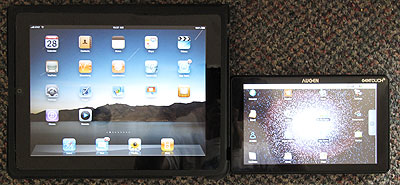 Before I go into details, let me give you the bottom line right here: the GenTouch78 is NOT a direct competitor of the Apple iPad. Anyone who views it as a less expensive iPad alternative needs to insantly forget about that notion. It is nowhere near as quick, polished or overall terrific as the iPad. Not even close. It is also, as you can see on the picture, significantly smaller than the iPad. Before I go into details, let me give you the bottom line right here: the GenTouch78 is NOT a direct competitor of the Apple iPad. Anyone who views it as a less expensive iPad alternative needs to insantly forget about that notion. It is nowhere near as quick, polished or overall terrific as the iPad. Not even close. It is also, as you can see on the picture, significantly smaller than the iPad.
That said, compared to old Pocket PCs and PDAs it is lightyears ahead. By those standards, the GenTouch is fast, competent, and offers an infinitely better browsing, communication and multimedia experience on a bigger, better display for much less money than any of the old PDAs ever did. In addition, it provides a tantalizing peek at a potential future of tablet computers, a post-Microsoft future where the Android platform may dominate the mobile market.

Android as an emerging potential tablet OS
While anyone viewing the GenTouch as an inexpensive iPad will be disappointed, this tablet is a very important technology demonstration as it previews where Android may fit in in future tablet devices. After all, all the experts and analysts predict that tens of millions will be sold.
Like it or not, but Apple's iPad has changed the world. Quickly dismissed by many upon its initial announcement early 2010, the iPad gained almost universal respect and millions have been sold. The iPad's capacitive touch screen and elegant, effortless user interface have totally redefined user expectations. And while the iPhone had already blazed the trail for clever, inexpensive apps that offer entertainment, productivity and great value, the iPad with its much larger screen elevated the phenomenon to an entirely different level. All of a sudden, tablets are hot, tablets are expected to eat deeply into the netbook market, and everyone scrambles to also offer a tablet, similar to the way the smartphone market scrambled to match or trump the iPhone over the past three years.
But it's not so easy. Though Microsoft has sort of been supporting a Tablet PC platform for the past eight years (and originally introduced Windows for Pen Computing almost two decades ago in response to the competiting PenPoint), Microsoft has no answer other than adding better touch functionality to Windows 7, including a couple of multi-touch demos. Hewlett Packard has a potential answer via the WebOS it now owns due to its acquisition of Palm. But unlike Apple's iPhone OS that beautifully scaled up to the iPad, Palm has yet to demonstrate if the same would hold true for WebOS, which to-date we've only seen on the tiny Palm Pre and Palm Pixi.
That leaves Android, an operating system/software alternative that came out of seemingly nowhere to be one of the leading and most promising mobile OS platforms. Android initially was a Silicon Valley startup, formed by the man behind the Danger Hiptop, that was bought by Google in 2005 and is now administered the Open Handset Alliance, a group of almost 70 companies developing open standards for handhelds.
Android is based on a Linux kernel which is well suited for mobile systems due to its modest hardware requirements. There have been several attempts at making Linux popular in the handheld space, but never with much success. Versions of Linux were available, on a hacker basis, for the old Compaq iPaq. Sharp had an entire line of handhelds based on Linux, the Sharp Zaurus 5000. None of those devices ever had an impact. The problem was always the underlying complexity of the Linux operating system, and the lack of a good user interface.
With Google behind Android, in late 2009, the Gartner market research firm predicted that by 2012, Android would become the world's second most popular smartphone platform, behind Nokia's Symbian OS, and Tim Bajarin of Creative Strategies said that "Android is steadily becoming the go-to OS for smartphones and tablets."
Where are Android tablets as of Summer of 2010?
However, as of this writing in late August of 2010, despite numerous announcement of imminent iPad competitors, there really aren't any. Android smartphones are selling by the millions, mainly via Motorola, HTC, Samsung, etc., but other than the Dell Streak, a mini tablet with a 5-inch display, and perhaps the Archos 5 with an equally tiny display, there's nothing so far. Nothing "real," I should say, because if you search for Android tablets on eBay, you'll find hundreds of aPads and ePads and others with 7 and 10 inch displays, all mimicking the iPad look, but really representing cheap Chinese hardware running one version of Android or another. An "Apad" tablet with a 7-inch screen is available for under US$100, shipping included.
There is, however, an alternative to eBay, and that's the Augen GenTouch 78. Augen is a Florida-based electronics company that has been selling inexpensive high-tech gadgets since 2004, with the goal of beating everyone else to market with their own branded products. Their 2010 lineup includes an eBook reader similar to the Amazon Kindle, a couple of Android-powered netbooks with 7 and 10.2-inch displays (the GenBook 78 and 108), and as of July 2010, the Augen Gentouch 78 Tablet PC. The Gentouch was introduced to the world via a US$149.95 offer in a KMart weekly advertising circular and that generated a lot of attention. Unfortunately, KMart must have jumped the gun a bit, as the product either quickly sold out or was unavailable in most stores. We tried to get one, but left with just a raincheck.
In the meantime, the reports from those who managed to score a GenTouch were decidedly mixed. Resistive touchscreen only, sluggish, unresponsive, cheap, etc., etc., the Augen tablet sure got hammered. We stopped by KMart two more times, but they still did not have any. We called again the day the raincheck expired and, low and behold, they now had a whole big shipment, like 12 of them. I jumped in the car and got it.
The Augen GenTouch78
So what exactly is the GenTouch78? A tablet, for sure, and a nicely sized one at that. Its wide-format 7-inch display is close in size to a netbook display, and much larger than any phone display. This means you get an entirely different and more satisfying browser and general usage experience than will ever be possible on a phone.
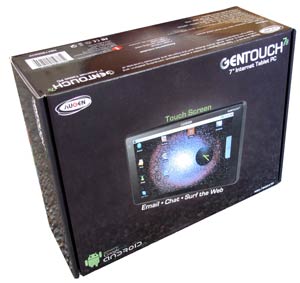 Unpacking the Augen tablet you find none of the elegant minimalist touch of Apple packaging where the box itself is jewel-like. It's basic cardboard and thin clear plastic here. Inside the box are the GenTouch78 device, a mini-USB to USB host cable, a mini-USB to Host client cable, an A/C adapter, a small (24-page) manual, and an elegant leather portfolio case. Unpacking the Augen tablet you find none of the elegant minimalist touch of Apple packaging where the box itself is jewel-like. It's basic cardboard and thin clear plastic here. Inside the box are the GenTouch78 device, a mini-USB to USB host cable, a mini-USB to Host client cable, an A/C adapter, a small (24-page) manual, and an elegant leather portfolio case.
The Augen tablet itself looks surprisingly elegant, mimicking the iPad's smooth, flat surface with the actual display bordered by a black flush bezel. But whereas the Apple's surface is glass-smooth and free of optical distortions, the Augen's resistive touchscreen relies on give, and its glossy (albeit not as glossy as the iPad) surface reflects with some distortions. It's also, as we found out, quite scratch-prone.
As stated above, the GenTouch is much smaller than the Apple iPad. While the difference between a 7-inch and a 9.8-inch display might not seem that much, it is. The footprint of the 7.3 x 4.5 inch GenTouch isn't even half that of the iPad. Resolution in terms of pixel per inch, though, is roughly the same: the iPad sports 1024 x 768 pixel while the Augen has 800 x 480 pixel, making for about 133 dpi for each. Which means that this is not some low-res display.
Much has been made of the slow boot time of the GenTouch, but that's misleading. Yes, it takes a bit to initially boot, as does the iPad, but once it's up, turning it off simply makes it go to sleep and from that it waks up instantly when you push the start button on the right side.
The technology inside the Augen GenTouch78
While almost all netbooks and most of the smaller tablets and vertical market devices we review here at RuggedPCReview.com are using Intel Atom processors, most smartphones and quite possibly also an emerging class of small tablets are using ARM-based processors, and that makes simple comparison of clock speed meaningless. The 1GHz A4 processor in the iPad makes the iPad feel very quick while the 1.6GHz processors in netbooks often struggle. So what's powering the GenTouch?
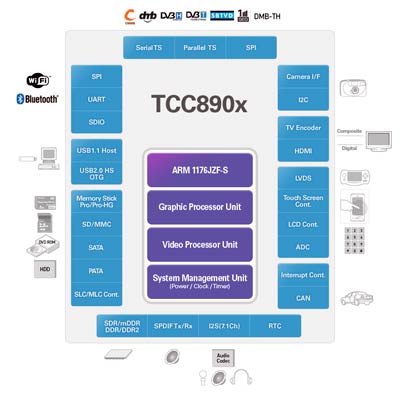 That would be a 720MHz Telechips TTC8902 processor, which its Korean maker calls "a system LSI for digital multimedia applications based on ARM1176JZF-S, an ARM's proprietary RISC CPU core" that implements the ARM11 ARM architecture v6. It combines the ARM1176JZF-S with a GPU, a video processor unit and a system management unit. The chip supports HD decoding and encoding, has a 3D graphics accelerator, and, at least according to its block diagram, about anything else you could ever want. That would be a 720MHz Telechips TTC8902 processor, which its Korean maker calls "a system LSI for digital multimedia applications based on ARM1176JZF-S, an ARM's proprietary RISC CPU core" that implements the ARM11 ARM architecture v6. It combines the ARM1176JZF-S with a GPU, a video processor unit and a system management unit. The chip supports HD decoding and encoding, has a 3D graphics accelerator, and, at least according to its block diagram, about anything else you could ever want.
The GenTouch has 256MB of DDR2 RAM in the form of two soldered Hynix HY5PS1G1631C 1GBit DDR2 SDRAM chips (see here), and a Samsung 2GB NAND Flash. The unit has 802.11b/g WiFi, GPS (or at least Google is somehow able to precisely locate the unit's location), and a slot of a microSD card. There's a 2.5mm audio in/out port, a mini-USB port and a speaker.
A large internal non-replaceable 8.4V 2,100mAH battery provides 17.6 watt-hours. That's not as much as the iPad's 25 watt-hours, but definitely quite a bit. In practice, it doesn't last nearly as long as the iPad on a charge, but that's likely a configuration issue.
The very nice 7-inch wide-aspect-ratio display comes from Hong Kong-based HLY (HongLianYing).
Below you can see what's inside the GenTouch tablet. Opening it up is simple: undo four small screws, then take a credit card to very gently pry the clamshell housing apart. The white background inside is the LCD/digitizer assembly. The large blue battery is glued to the back of the LCD. The main circuit board is small and simple. The ribbon cable covers the processor and memory chips. The green circuit board to the right is a mystery as it is not connected to anything.
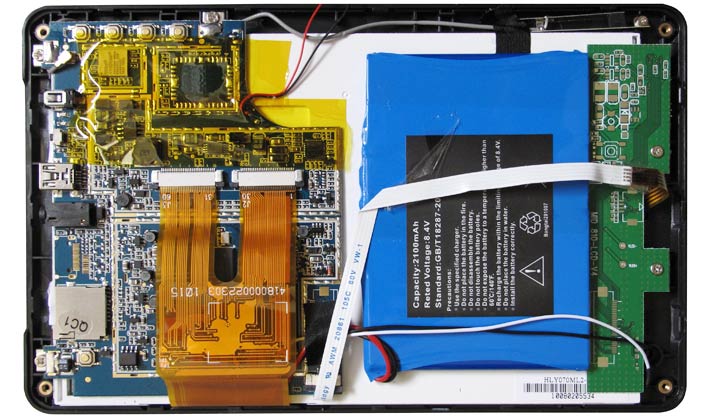
For another discussion of what's inside the Augen tablet, check 11H blog.
Using the Augen GenTouch78
But now let's take a look at how the Augen tablet works. From a cold start, it takes a bit for the device to boot. After that, when it goes to sleep, pushing the power button wakes it up again instantly.
When I used it for the first time, I was treated to a most impressive looking desktop that looks like a rotating galaxy of swirling stars, thousands of them. You also have icons of the major apps, and you notice that the display is much better than expected. It's very bright, has very good contrast, has a perfect 180 degree horizontal viewing angle, and also a very wide vertical viewing angle. Below you can see the tablet's desktop (after I replaced the somewhat resource-intensive galaxy wallpaper with a static picture):
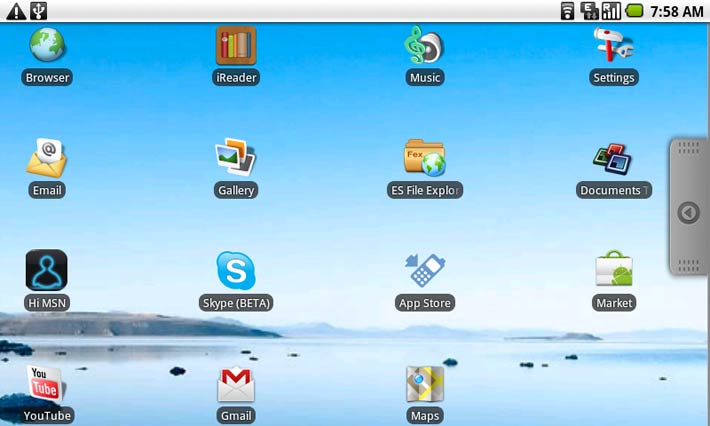
If you're new to Android, at this point it would be a good idea to familiarize yourself with Android basics. Android being a Google project means you'll need a Google account to use the major Google apps or to download apps from Google Market, or synchronize the device via Google. Unfortunately, Augen and Google are having a bit of a rocky relationship, and so GenTouch78 buyers may or may not have Google apps on their device.
Android also has a number of icons that shows the time, signal strength, battery status and a whole slew of different notification icons in a bar on top of the screen. It took me a bit to figure out that you have to drag down on the status bar like a blind to see what the notifications are, and to manage them. I also had to figure out that Android has both a home screen with icons on it and a launcher that opens like a drawer and contains all the rest of your app icons. If you have more programs, you can simply scroll down to view them. Below you can see the launcher:
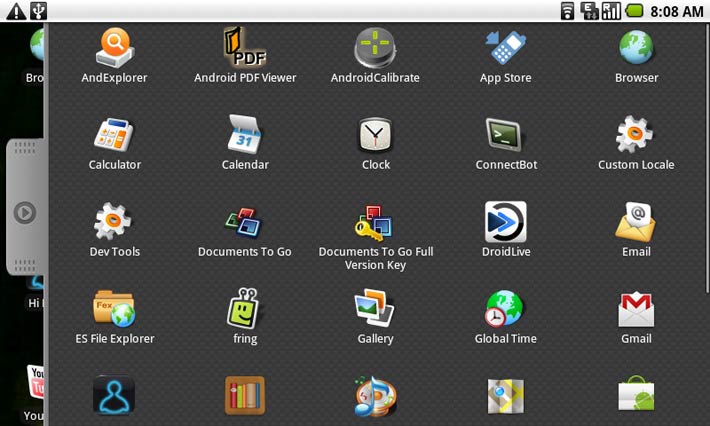
Finally, you can drag the home screen left and right to get to two additional home screens, or extensions to the home screen. You can place widgets, shortcuts, folders or wallpaper on those extensions.
It's quite clear that Android was designed for touch, including swipes and slides and pinches and multifinger gestures, and that all works much better with a capacitive digitizer than with a resistive one. But that is what the Augen tablet has. So get used to using it with a stylus. You'll save yourself a lot of frustration.
So Android operation is via stylus (or touch if you are willing to put up with it), and four small hardware buttons in the back of the unit that correspond to the four primary buttons present on almost every Android device:

- Back
- Menu
- Search
- Home
Those buttons are ever-important in operating an Android device, and having them in the back where you cannot see them or even feel them very well because of their small size is perhaps not the best idea. Missing, unfortunately, are physical volume controls.
Since the GenTouch doesn't have a physical keyboard, you need to use the onscreen keyboard for all data entry. Some apps will open it for you, with others you need to tap on a text box. The keyboard looks very much like Apple's, with clean, uncluttered letters. However, at least on the GenTouch, the keyboard is far too sluggish and unresponsive to be suitable for more than very occasional data entry. This is clearly not a device for writing. And since this is not a phone and doesn't have a built-in microphone that I could tell, there's also no way of entering text via speech reco.
While Android doesn't currently use multiple windows or some other visible way to handle multi-tasking, apps do continue running and you can return to them even after using another. To do that you simply hold the Home button to make a small window appear that shows the icons of recently used, and still running, apps. Below you can see what that looks like:
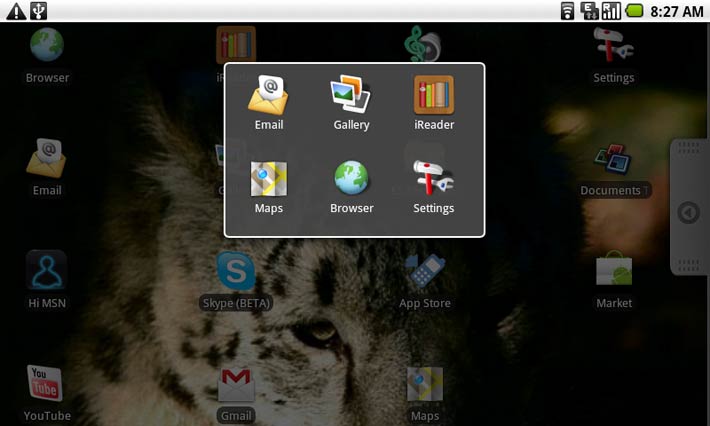
Almost all apps have menus that you bring up by tapping the Menu button. In some instances, there are also context menus that come up by touching and holding an item, like on the iPad.
Below you can see the very competent browser with its primary menubar displayed:
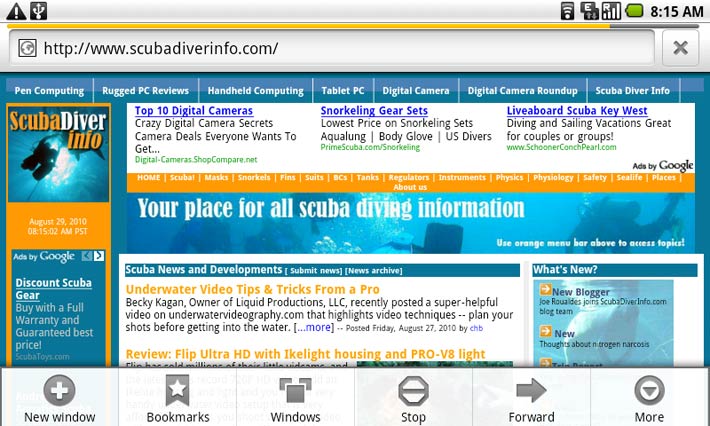
For additional menu choices or options, you'd simply tap on "more".
The browser also offers a very convenient "Favorites" screen so you can quickly go to them without having to type in the URL:
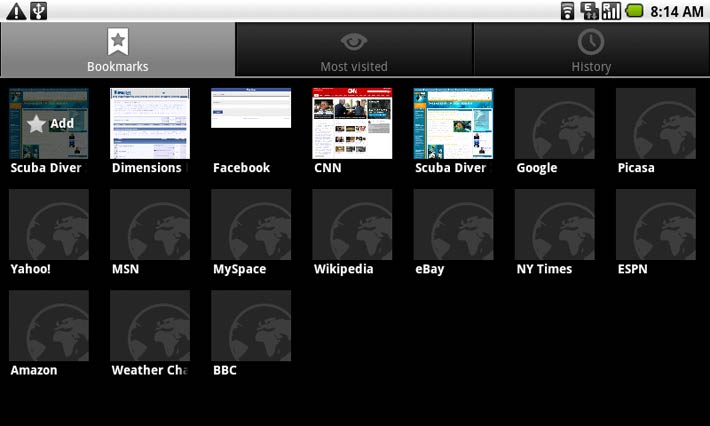
With File Explorer you can list and access local files, files on your local area network, files via FTP and Bluetooth connections (the GenTouch doesn't have Bluetooth). Below are screens showing local access and LAN access:

The Android Market app provides access to the all-important official Android market. Unfortunately, as of this writing (August 29, 2010), while you can see the market from a GenTouch, you can't download. Attempting to do so will simply show the "Starting download..." forever.
It is not entirely clear to me if this access problem is simply a programming glitch or whether Google seriously does not want for the likes of the Augen tablet to access its Market. As is, below you can see what the Google Market looks like:
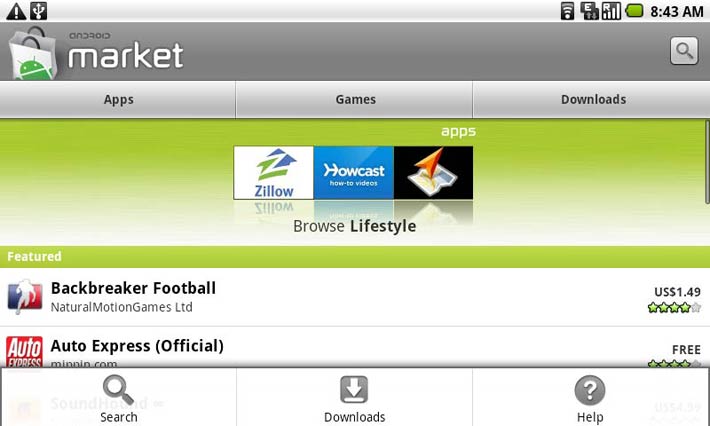
Since access to the Android Market is iffy on the Augen tablet, it includes an alternate, Funky Android's AndAppStore. AndAppStore is a third party app store and you need an AndAppStore account that you can get at andappstore.com. There are far fewer apps here, but that may change over time.
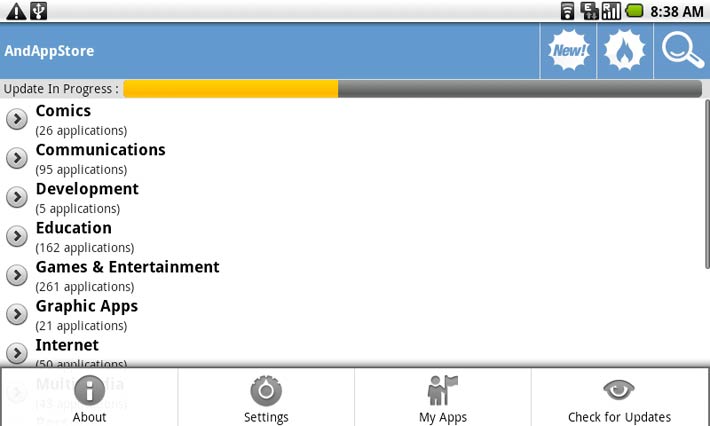
There's a Skype Beta app that lets you access your account, but since the GenTouch isn't a phone, it's mostly usable for chatting. Also, the app screen size is smaller than the GenTouch screen. Below is the Skype screen and also the Maple Player app that somehow found its way onto our tablet:

The Maps application works exceptionally well. It's quick, shows both maps and satellite views, lets you use some overlays, and you can get turn-by-turn directions. While the GenTouch reportedly does not have GPS, Maps did find my location quickly and precisely via WiFi.
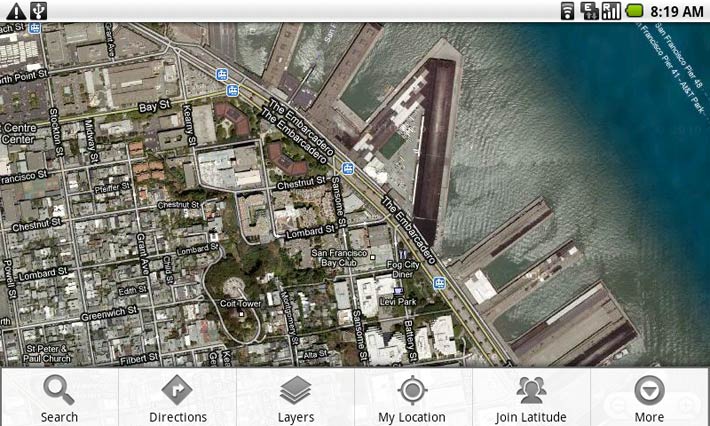
Dataviz's Documents To Go was installed, and it can read and write word processing, spreadsheet, and presentation files, and also display PDF files. It was very slow and didn't work quite right on my machine. I also tried QuickOffice, but that one came in a tiny screen format and didn't work for me. I know both of these office suites from other platforms and they work very well, so this was another case of growing pains in getting a new platform to work.
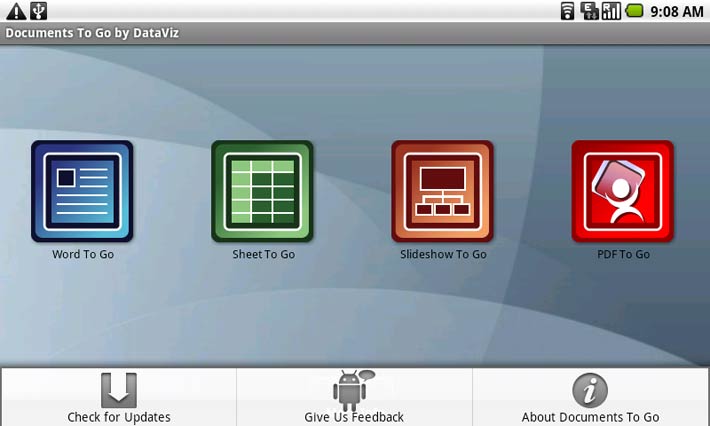
And speaking of things that didn't work right, the audio on my GenTouch did not work properly either. For the most part, all I got was loud scratchy noises. Most regular customers would instantly have returned the device for something as important as that, but since I don't use the device for music I decided to put up with it and hope I'll find a fix for it.
The screen shots shown here didn't come easy, by the way. I had to download the Android SDK from developer.android.com, make sure I had the right version (Android 2.1), then use an online tutorial (see here on YouTube) to figure out how to run the Android SDK and AVD Manager to create an Android Virtual Device with the proper screen size, start it, connect the GenTouch via USB and with USB debugging on and wait until it was recognized, then load ddms (the Dalvik Debug Monitor) to get screen captures. Getting this to work was another example of how it's almost always possible to find/fix/configure things with an emerging technology device like the GenTouch/Android combo, but also how that can burn up a great deal of time and effort, like when you get deeply into Linux.
One app that worked exceptionally well was YouTube. I could easily browse clips and watch them run flawlessly.
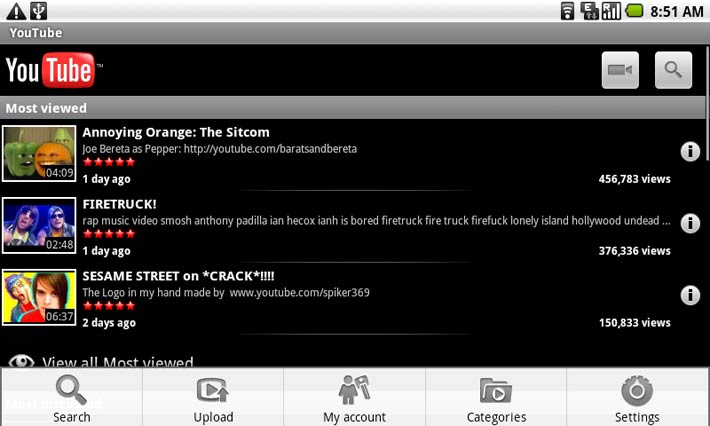
For a few additional sample screen captures from the Augen tablet, see here.
The iPad often gets criticized for not having a card slot or USB port to copy things to and from. Well, the GenTouch has both, but it still isn't easy to copy things to and from. For example, copying from a PC to the Augen goes to "internal storage" which is so well hidden in the file system that even Laptop Magazine said, "we were unable to find it on the GenTouch78." It is, actually, the /nand root level directory in the Android file system, and therefore quite confusing, as /nand is not exactly a user-friendly destination, and apps may or may not let you even look there for data.
Bottom line for the Augen GenTouch78
So there, that's the scoop on the Augen GenTouch78. It's really a curious product. You get some very good stuff (like the excellent 7-inch display, good performance, big battery, powerful 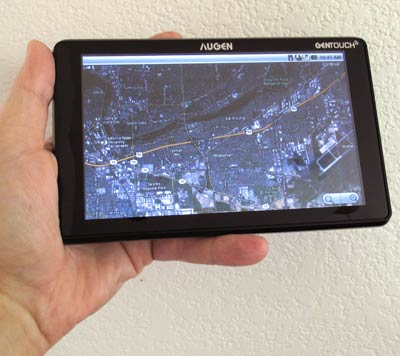 software, etc.) in a very inexpensive device that may well be one of the early trailblazers in an emerging Android tablet market. This little tablet does an awful lot, and it does it better than any of the old Pocket PCs ever did. software, etc.) in a very inexpensive device that may well be one of the early trailblazers in an emerging Android tablet market. This little tablet does an awful lot, and it does it better than any of the old Pocket PCs ever did.
Problem is, it's running a potentially very important OS on a tablet at a time where that OS is still mostly implemented only on phones, it's doing so with apparently a cold attitude from Google, and the inexpensive hardware, while not inelegant, cannot possibly be as polished as what comes out of Apple.
Augen's biggest problem with the GenTouch is that it looks so much like a little iPad that people will invariable pick it up and try to use it like an iPad, swiping, dragging, pinching, which is exactly what it cannot do.
The name, GenTouch, also doesn't help as this is NOT a natural touch device. You operate it with a stylus, like a PDA, and Android really wants touch.
Augen is absolutely to be congratulated to even embark on this project. Yes, it needs a capacitive touch screen. Yes, cheap hardware can only do so much. Yes, a small staff will be very hard pressed to truly make a new OS work on it, and provide the help and support a product like this will require. But Augen showed it can be done, and I am really glad they did it.
What the Augen GenTouch78 is:
- One of the first tablets to run the Android OS (version 2.1)
- A great and inexpensive way to get familiar with Android without signing a 2-year telco contract
- A cool little tablet with a great, contrasty 800 x 480 pixel display
- Fully capable of web browsing
- Excellent Maps and YouTube apps
- Capable of running a large variety of very powerful apps and utilities
- Expandable via microSD card slot
- Quite fast in most operations
- Very inexpensive, and actually offering very good value
- Faster, more powerful and offering a larger display than any Pocket PC/PDA ever had
And what it is NOT:
- An iPad replacement
- A truly finished product
- Able to download from the Google Market Place
- Run as long as its big battery suggests
- Easy to operate, what with those tiny buttons in the back
- Have a keyboard fast enough for ANY serious data entry
- Really suitable to run an OS that needs a capacitive touchscreen, and not a resistive one
– Conrad H. Blickenstorfer, August 2010
|
Augen GenTouch78 Android tablet Specifications
|
| Added/changed |
Added 8/2010 |
| Type |
"Internet Tablet PC" |
| Processor |
ARM11-based 720MHz Telechips TTC8902 |
| OS |
Android 2.1 |
| Graphics Controller/Chipset |
integrated |
| Memory |
256MB DDR2 SDRAM (2 Hynix HY5PS1G1631C chips) |
| Storage |
2GB Samsung NAND Flash |
| Display |
7.0" WVGA (800 x 480 pixel ) TFT LCD with CCFL backlight |
| Digitizer/Pens |
Resistive Touch/stylus included |
| Keyboard |
Onscreen |
| Multimedia Pocket |
none |
| Slots |
1 microSDHC |
| Housing |
Plastic (black) |
| eBook support |
Text, PDF, E-PUB, HTML |
| Media support |
MP3, WMA, FLAC, AAC |
| Picture Viewer |
JPG and BMP |
| Outdoor viewability |
marginal |
| Size (inches) |
7.2 x 4.5 x 0.6 inches |
| Weight |
12.2 ounces |
| Power |
8.4V/2,100mAH (17.6 watt-hour) Li-Ion battery |
| Communication |
Atheros-based 802.11b/g |
| Interface |
1 mini-USB 2.5mm audio jack for mic/headphone, power, (HDMI support on board, but no connector) |
Price |
US$169.99 at KMart |
| Website |
Augen US website went offline 2011 |
|
| |



